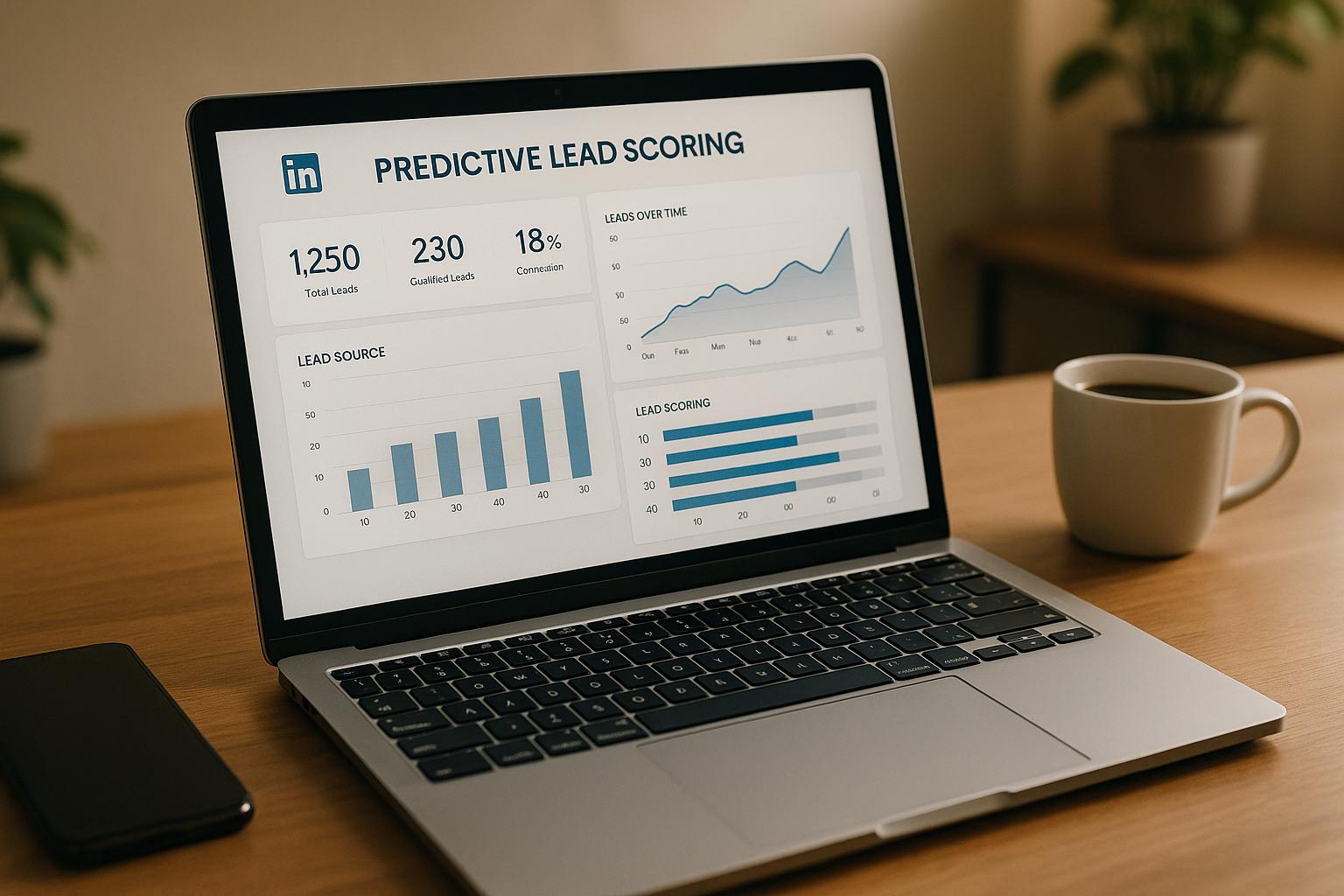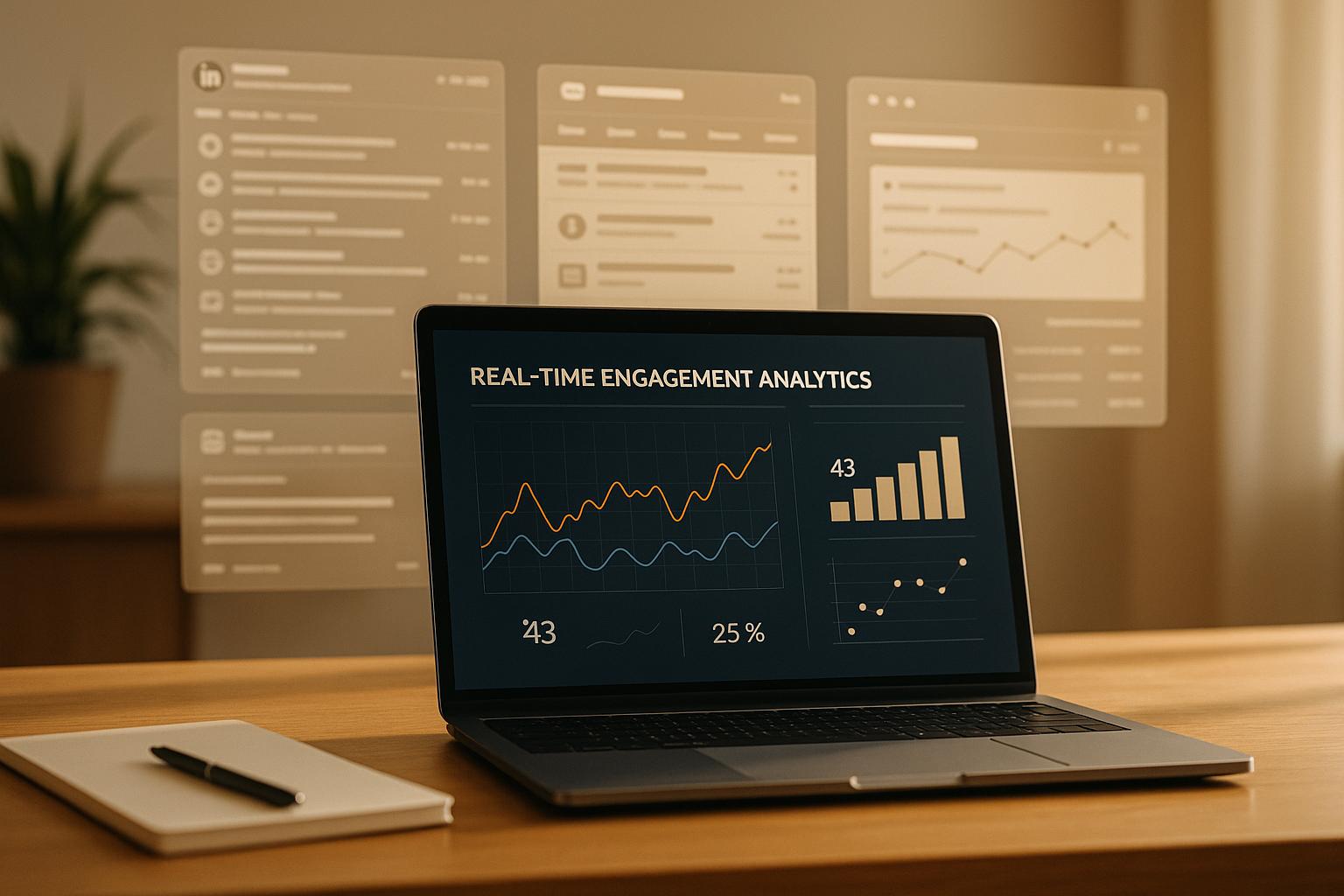
.avif)
Julien Gadea
Julien Gadea specializes in AI prospecting solutions for business growth. Empowering businesses to connect with their audience with SalesMind AI tools that automate your sales funnel, starting from lead generation.
Predictive lead scoring transforms LinkedIn outreach by analyzing data to prioritize high-potential leads. Unlike basic scoring, which uses fixed criteria like job titles or company size, predictive scoring leverages machine learning to evaluate behaviors, engagement history, and external signals. This approach improves accuracy, saves time, and increases conversion rates by focusing resources on leads more likely to convert.
Key Takeaways:
- Basic Scoring: Relies on static rules and demographic data; easier to implement but less precise.
- Predictive Scoring: Uses machine learning and historical data for dynamic, data-driven insights.
- Impact: Predictive scoring boosts LinkedIn campaign efficiency, enabling targeted messaging and better use of tools like Sales Navigator.
For businesses with strong data, predictive scoring is essential for maximizing LinkedIn campaign results.
Qualify Leads with AI & Score Prospects Using LinkedIn & Websites (n8n)
1. Basic Lead Scoring
Basic lead scoring is a straightforward system that uses a point-based approach to evaluate a lead’s potential based on predefined criteria - like senior job roles or working for large companies. It acts as a foundational step before transitioning to more advanced and predictive techniques.
Methodology
At its core, basic lead scoring depends on manually created rules and fixed criteria. Sales managers set these rules by analyzing traits of previously successful conversions and then regularly update them. The system often works with a threshold model: leads that score above a certain point are marked as "sales qualified."
The scoring process typically focuses on two main areas: demographic details and behavioral actions. Demographic scoring looks at factors like job titles, company size, industry, and location. Meanwhile, behavioral scoring tracks actions such as opening emails, visiting websites, or downloading resources. However, this method tends to evaluate each data point individually, often missing the bigger picture that emerges when combining multiple signals.
Data Inputs
Basic lead scoring relies on a small set of easily accessible data sources. Much of the demographic information comes from LinkedIn profiles, which provide details like job titles, company names, and industry classifications. This data is often complemented by information from company websites, press releases, or firmographic databases. Behavioral insights, such as profile views or responses to messages, add another layer of understanding.
The data collection process is usually reactive, with updates happening periodically - such as when profiles are refreshed or new contact lists are imported. This approach can result in outdated or incomplete information, leaving gaps in the data.
Accuracy and Efficiency
While basic lead scoring offers some improvement over random outreach, its accuracy is moderate at best. It helps identify prospects more likely to convert, but there’s still room for misclassification. Leads marked as "qualified" may not always convert, and genuinely interested prospects might be overlooked due to lower scores.
On the efficiency front, the system does save sales teams time by reducing the pursuit of poor-quality leads. However, the manual effort required to update scoring rules can be time-consuming. Additionally, the system may overvalue flashy job titles or large companies while undervaluing less obvious but promising decision-makers.
Impact on LinkedIn Campaign Performance
When applied to LinkedIn campaigns, basic lead scoring can improve response rates by narrowing outreach to leads that match established criteria. This approach allows for more personalized messages tailored to roles and company profiles. It also helps sales teams maximize the use of premium tools like LinkedIn Sales Navigator and InMail credits by focusing on higher-scoring leads, making better use of their budgets and time.
That said, basic lead scoring has its limits. While it’s effective for filtering out poor matches, it struggles to differentiate between moderately good leads and those with significant potential. These shortcomings highlight the need for more advanced methods, which will be explored in the next sections.
2. Predictive Lead Scoring
Predictive lead scoring takes a smarter, data-driven approach by using machine learning algorithms and historical data to predict which leads are most likely to convert. Unlike traditional systems that rely on fixed rules, predictive models continuously refine their criteria based on actual outcomes, making them more adaptable over time.
Methodology
This approach harnesses the power of artificial intelligence to analyze massive amounts of data simultaneously, uncovering patterns that might go unnoticed by human analysts. Instead of assigning static point values to specific attributes, the system evaluates how different combinations of factors correlate with successful conversions.
By processing historical conversion data, machine learning assigns dynamic probability scores to new prospects. This method has a proven track record - companies using predictive analytics are 2.9 times more likely to report revenue growth above the industry average [6]. The ability to refine predictions over time gives businesses a clear edge in competitive markets.
Data Inputs
Predictive lead scoring relies on a vast and diverse range of data to create detailed prospect profiles. The more robust the data, the more accurate and effective the scoring becomes [2][3][4][6]. Here’s a breakdown of the types of data it uses:
- Demographic and firmographic data: This includes information like job titles, company size, industry, revenue, and location. Platforms like LinkedIn provide valuable professional details to enrich these profiles.
- Behavioral data: Tracks how prospects interact across touchpoints, such as viewing profiles, engaging with content, responding to messages, or visiting websites. These real-time signals reveal interest and intent.
- External data: Adds context by pulling in information like company news, funding announcements, technology stacks, and market trends. These external signals highlight prospects undergoing changes that could trigger buying decisions.
- Historical conversion data: Serves as the foundation for training machine learning models. By analyzing past successes, the system learns which combinations of factors lead to conversions and applies those insights to future predictions.
Accuracy and Efficiency
Predictive lead scoring outperforms traditional methods by delivering higher accuracy and improving efficiency. Sales teams using this approach see a 30% boost in efficiency, with qualified leads being 10 times more likely to convert and an average closing rate of 14.6% [1][5].
The system’s ability to process and analyze enormous datasets in real-time means sales teams can focus on high-potential leads instead of wasting time on manual evaluations. Over time, the learning algorithms improve accuracy without requiring constant manual adjustments.
Predictive models are particularly effective at spotting hidden patterns. For example, they might identify that leads from companies with recent leadership changes are more likely to convert or that specific combinations of job titles and company sizes yield better results. These insights are nearly impossible to uncover manually.
Impact on LinkedIn Campaign Performance
When applied to LinkedIn campaigns, predictive lead scoring takes performance to the next level. By assigning conversion probability scores, it enables hyper-targeted messaging that focuses on the most promising prospects. Sales teams can allocate premium LinkedIn resources - like InMail credits or Sales Navigator searches - toward leads with the highest likelihood of success.
The system also supports dynamic campaign optimization, adjusting targeting criteria in real time based on performance data. For instance, if the model detects higher conversion rates within a specific industry, it can recommend shifting more resources to those prospects.
Combining predictive scores with behavioral insights allows for deeper personalization. Sales reps can craft messages that address specific challenges or opportunities identified by the algorithm, leading to better engagement and higher-quality conversations.
Platforms like SalesMind AI illustrate this approach in action. By integrating AI-driven predictive scoring with automated LinkedIn outreach, tools like a unified inbox and automated follow-ups ensure that high-potential leads receive timely attention. This not only improves response rates but also ensures efficient use of LinkedIn's premium features, ultimately maximizing return on investment for sales campaigns.
sbb-itb-817c6a5
Pros and Cons
When it comes to LinkedIn campaign performance, basic and predictive lead scoring methods each bring their own advantages and challenges. Here's a closer look at what sets these approaches apart and how they impact your strategy.
Basic lead scoring is often praised for its straightforwardness. It works by assigning simple engagement values, such as points for profile views or message responses. This rule-based system is easy to implement, making it ideal for smaller teams or businesses new to lead qualification. However, its simplicity can also be a drawback. Since it relies on static criteria, it struggles to handle complex data or adapt to changing market conditions.
On the other hand, predictive lead scoring uses a data-driven approach to deliver greater precision and flexibility. Ben Rose highlights that traditional scoring methods fall short in today’s data-rich environment, whereas predictive scoring taps into historical data and machine learning to create dynamic, outcome-focused scores [7]. This approach reduces guesswork and adapts automatically to market shifts, making it especially effective for identifying high-potential leads.
Predictive models excel at uncovering intricate, non-linear patterns that basic methods often overlook. For instance, HubSpot discovered that prospects from SaaS companies with 50–200 employees who engaged with product features, read case studies, and visited pricing pages - then responded to Tuesday emails - converted at rates 78% higher than average [2]. That level of insight simply isn’t achievable with basic scoring.
However, predictive scoring isn’t without its challenges. It requires a wealth of historical data, which can be a hurdle for newer companies or those without comprehensive analytics.
| Feature | Basic Lead Scoring | Predictive Lead Scoring |
|---|---|---|
| Methodology | Static point-based rules; manual updates | Machine learning models with automated refinement |
| Data Inputs | Limited (5–10 attributes); basic demographics | Extensive (hundreds of data points); detailed analytics |
| Accuracy | Assumption-based; prone to bias | Data-driven; continuously improves over time |
| Adaptability | Requires manual updates for market changes | Real-time adjustments to changing conditions |
| Implementation | Quick to set up; needs ongoing maintenance | Complex to set up but largely automated afterward |
Choosing the right method depends on your resources and goals. For LinkedIn campaigns, these differences directly shape how you allocate resources and personalize your outreach. Tools like SalesMind AI demonstrate how predictive scoring, combined with LinkedIn automation, can pinpoint high-value prospects and make the most of InMail credits and Sales Navigator.
If you have access to extensive historical data, predictive scoring can be a game-changer. But for smaller teams or simpler products, basic scoring might still get the job done.
Conclusion
Predictive lead scoring has proven to be a game-changer for LinkedIn outreach in the highly competitive US B2B market. While basic scoring methods are quick and simple to implement, they fall short when it comes to delivering the precision and flexibility that today’s outreach strategies demand.
Businesses leveraging predictive scoring see better conversion rates and uncover detailed engagement trends that traditional methods often overlook. In LinkedIn’s data-rich landscape, this approach addresses critical challenges like optimizing resource allocation and improving outreach effectiveness. Plus, its ability to adjust automatically to shifting market conditions eliminates the need for constant manual updates.
By adopting predictive lead scoring, companies can maximize their resources and focus on higher-quality leads. Tools such as SalesMind AI highlight how advanced scoring systems and automation can simplify and enhance the entire outbound process.
For organizations with strong historical data and a goal to thrive in the US market, predictive lead scoring is no longer just an option - it’s a necessity. Embracing this technology now ensures a competitive edge as LinkedIn continues to evolve.
FAQs
What makes predictive lead scoring more accurate than basic lead scoring?
Predictive lead scoring takes lead evaluation to the next level by analyzing a wider array of data and applying advanced analytics to predict how likely a lead is to convert. Unlike basic lead scoring, which often depends on static factors like a prospect's job title or the size of their company, predictive lead scoring integrates real-time behavioral data - such as website visits and content interactions - along with historical sales trends, demographic details, and firmographic insights.
With the help of machine learning and predictive analytics, this method constantly evolves as new data becomes available. The result? Businesses gain sharper, more dynamic insights, enabling them to prioritize leads with greater precision and focus their LinkedIn outreach efforts on those most likely to turn into customers.
Which types of businesses can benefit the most from using predictive lead scoring in their LinkedIn campaigns?
Predictive lead scoring proves particularly useful for B2B companies like SaaS providers, marketing agencies, consulting firms, and coaching services. These types of businesses often turn to LinkedIn to network with decision-makers. By leveraging predictive analytics, they can pinpoint high-quality leads, direct their efforts toward the most promising prospects, and ultimately improve conversion rates.
This approach simplifies the process of qualifying and prioritizing leads, allowing businesses to save time, enhance sales efficiency, and see stronger outcomes from their LinkedIn campaigns.
What challenges do businesses face with predictive lead scoring, and how can they address them?
Predictive lead scoring comes with its fair share of challenges. Common hurdles include inaccurate data, misalignment between sales and marketing teams, technical difficulties, outdated scoring models, and low team engagement. These issues can significantly impact the success of your outreach efforts.
To tackle these obstacles, start by prioritizing data quality - clean, accurate data is the foundation of effective lead scoring. Encourage stronger collaboration between your sales and marketing teams to ensure everyone is on the same page. Simplify technical workflows to make processes more manageable, and don’t forget to regularly update your scoring models to keep them relevant in a changing market. Equally important is ensuring your team understands the scoring process and feels invested in its success. By addressing these key areas, businesses can maximize the potential of predictive lead scoring and achieve better results, especially with LinkedIn campaigns.




